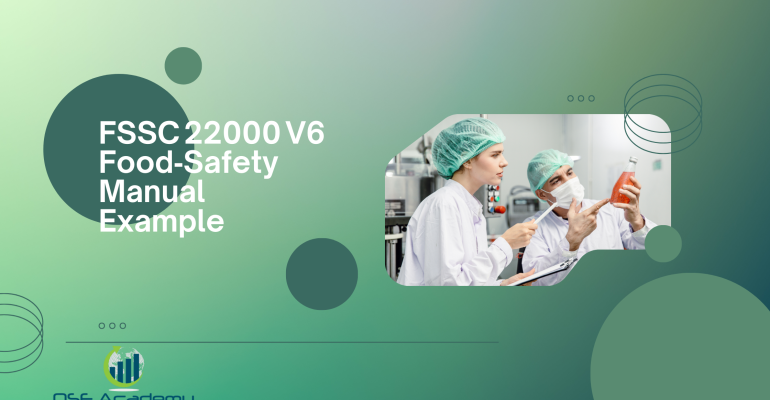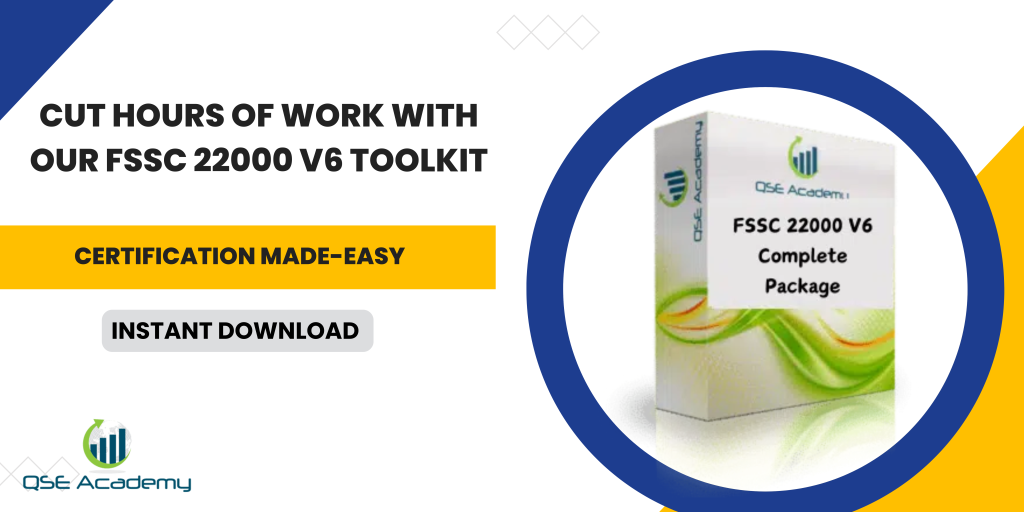FSSC 22000 V6 Food‑Safety Manual Example
What an FSSC 22000 V6 Food-Safety Manual Really Is (and Why It Matters)
If you’re implementing FSSC 22000 V6, you’ve probably noticed how documentation can quickly spiral into chaos. You’ve got procedures, records, PRPs, and hazard analyses — but when the auditor asks, “Show me your Food-Safety Manual,” things suddenly get quiet.
Here’s the truth: your Food-Safety Manual isn’t just another binder. It’s the map that connects all parts of your Food-Safety Management System (FSMS) — showing how leadership, operations, and control measures work together.
I’ve seen well-run factories fail audits simply because their documentation lacked structure. This article walks you through what an effective FSSC 22000 V6 Food-Safety Manual should contain, how to organize it, and a simple example you can adapt today.
You’ll learn:
- What the manual’s purpose really is
- How to align it with ISO 22000:2018 and the ISO/TS 22002 series
- How to include FSSC V6’s Additional Requirements without drowning in text
Purpose and Scope of the Food-Safety Manual
Your manual starts by defining what’s covered and what’s not. That means describing your product categories, processing sites, and applicable PRP standards.
A clear scope sets expectations for auditors and staff alike. For instance:
“This Food-Safety Management System covers the manufacture, storage, and dispatch of frozen vegetables under ISO/TS 22002-1 requirements.”
Pro Tip: Add an annex listing your sites, processes, and outsourced services. It keeps scope statements crisp while still being transparent.
Common mistake: Copying another company’s scope and forgetting to adapt it. Auditors check for consistency between your certificate, your manual, and your actual operations. If they don’t match, you’ll get a nonconformity before page two.
 Structure of the Manual — Linking Clauses to Procedures
Structure of the Manual — Linking Clauses to Procedures
A strong Food-Safety Manual mirrors ISO 22000 clauses 4 to 10, so every element connects back to a procedure or record.
Here’s a simple structure that works:
| Clause | Title | Reference Procedure / Record |
|---|---|---|
| 4 | Context of the Organization | FSMS-PROC-04 |
| 5 | Leadership & Policy | FSMS-PROC-05 |
| 6 | Planning & Risk Management | FSMS-PROC-06 |
| 7 | Support (Training, Communication, Documentation) | FSMS-PROC-07 |
| 8 | Operation (PRPs, HACCP, OPRPs) | FSMS-PROC-08 |
| 9 | Performance Evaluation | FSMS-PROC-09 |
| 10 | Improvement | FSMS-PROC-10 |
Example: One bakery client linked each section of their PDF manual to live SOPs stored on their document-control portal. When the auditor asked for the internal audit procedure, one click and it was open. That efficiency sets the tone for a smooth audit.
Key Sections of an FSSC 22000 V6 Food-Safety Manual
Your manual doesn’t need to be long — just clear, complete, and consistent. These are the core sections every auditor expects:
Food-Safety Policy and Objectives
State your company’s food-safety commitment in plain language. Keep it signed, dated, and displayed. Objectives should be measurable — think “Zero major nonconformities” or “Reduce customer complaints by 10%.”
Roles and Responsibilities
Outline who’s responsible for what. Define the FSMS Team Leader, HACCP team, and department heads. Clear accountability shows system maturity.
Product and Process Descriptions
Include short process summaries and flow diagrams. A visual overview helps both new employees and auditors understand your operation quickly.
PRP Summary
List your implemented Prerequisite Programs — sanitation, pest control, supplier approval, equipment maintenance, etc. Reference their detailed SOPs, don’t rewrite them.
HACCP Plan Overview
Summarize your hazard analysis, CCPs, OPRPs, and control measures. Include a table showing monitoring, verification, and corrective actions.
Additional Requirements Summary
FSSC 22000 V6 adds mandatory topics like Food Defense, Food Fraud, Allergen Management, Environmental Monitoring, and Quality Culture. A brief summary with cross-references to each procedure is enough.
Document Control and Review
Explain how documents are approved, updated, and archived. Version control and approval signatures show that your system is actively managed.
Pro Tip:
Keep this section visual — use tables, flowcharts, and icons. Auditors read faster, and your team understands procedures better.
Common pitfall:
Writing the manual like an academic report. Keep it operational, not theoretical.
Style, Tone, and Format That Auditors Appreciate
Auditors read dozens of manuals each month. The ones they value most are simple, direct, and well-organized.
Here’s what helps:
- Use active voice: “The Quality Manager reviews supplier approvals monthly.”
- Keep the manual under 30 pages if possible.
- Include revision history and approval details.
- Use consistent formatting for tables, clause references, and numbering.
Example: A confectionery plant integrated its manual with process maps and color-coded charts for CCPs. The lead auditor called it “the cleanest layout seen this year.” That’s what clarity looks like.
Pro Tip: Avoid repeating entire procedures. Just link or reference them — this keeps your manual lean and easier to maintain.
Maintaining and Updating the Manual
Your Food-Safety Manual is a living document, not a one-time project. Schedule updates at least once a year or whenever there’s a major change in product, equipment, or regulation.
Actionable advice:
Tie manual reviews to your management-review meetings. That way, updates become part of your improvement cycle instead of a forgotten task before an audit.
Common pitfall:
Letting the manual gather dust after certification. I’ve seen sites where the last update was dated “2019” — it’s an instant red flag for auditors.
Pro Tip:
Maintain a Document Review Log showing what changed, who approved it, and when. It’s simple proof of continual improvement.
Benefits of a Well-Structured Food-Safety Manual
When your manual is structured right, everything else runs smoother:
- Audits go faster — auditors find information instantly.
- Employees understand their roles and responsibilities better.
- Integration with ISO 9001 or ISO 14001 becomes straightforward.
- Regulatory and supplier audits become less stressful.
Quick example:
A spice manufacturer I worked with passed their first FSSC audit with zero major findings. The reason? Their manual clearly mapped every clause, procedure, and record. The auditor even asked to use it as a reference example for future clients.
FAQs — FSSC 22000 V6 Food-Safety Manual Explained
Q1. Is a Food-Safety Manual still mandatory under FSSC 22000 V6?
Yes. While ISO 22000:2018 doesn’t explicitly require a “manual,” FSSC and most certification bodies still expect one that summarizes your FSMS structure and scope.
Q2. Can I merge the Food-Safety Manual with my Quality Manual?
Yes — integration works well if sections stay traceable to food-safety clauses and FSSC V6 Additional Requirements.
Q3. Who maintains the manual?
Typically, the FSMS or Quality Manager maintains it, while top management reviews and approves updates.
Conclusion — Your Next Step to a Complete Food-Safety Manual
A good Food-Safety Manual doesn’t just satisfy auditors — it guides your team, protects your brand, and strengthens trust. It’s the anchor of your FSSC 22000 V6 system.
At QSE Academy, we’ve helped hundreds of food companies build documentation that passes audits the first time. Most realize their biggest challenge isn’t compliance — it’s structure.
If you want to save weeks of writing and avoid the typical audit stress, download our FSSC 22000 V6 Food-Safety Manual Template or book a free consultation. We’ll help you tailor it to your process in days, not months.
Melissa Lavaro is a seasoned ISO consultant and an enthusiastic advocate for quality management standards. With a rich experience in conducting audits and providing consultancy services, Melissa specializes in helping organizations implement and adapt to ISO standards. Her passion for quality management is evident in her hands-on approach and deep understanding of the regulatory frameworks. Melissa’s expertise and energetic commitment make her a sought-after consultant, dedicated to elevating organizational compliance and performance through practical, insightful guidance.








